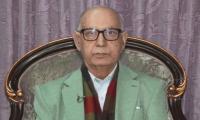LAHORE: As Pakistan continues to struggle against the wild poliovirus and the life-long disability it causes, country's largest media house, the "Jang Group and Geo Television Network" has now entered the fray with a zeal to spread awareness about the very high frequency of the disease in this part of the world, its prevention and cure.
Here follows a few vital historic facts about polio:
On February 18, 2020 (Tuesday), the Secretary General of the United Nations, António Guterres, had visited a kindergarten school in Lahore during the first nationwide polio campaign of the year and vaccinated three students with the polio vaccine. More than 39 million children across the country are set to be vaccinated during the February campaign.
There are currently 265,000 frontline workers who go door to door during campaigns to ensure that as many Pakistani children as possible are vaccinated against polio. Almost 62 per cent of these workers are female.
According to the World Health Organisation (WHO), during 2019, Pakistan was confronted with a resurgence of polio beyond traditional strongholds of the virus. There are 17 cases thus far in 2020.
Currently, only Pakistan and Afghanistan remain endemic and have sadly reported Polio cases.
August, 21, 2019 had marked a major milestone in the history of Nigeria, as the country had reached three years without reporting a case of poliovirus.
But those affected by polio can gain inspiration from many famous people who became victims of polio during their lives.
These include former four-time American President Franklin Delano Roosevelt (who contracted polio in 1921 at the age of 39 and used a wheelchair thereafter, though he attempted to hide his paralysis during public appearances), Nazi leader Adolf Hitler's Information wizard and father of modern propaganda Dr Joseph Goebbels, legendary filmmaker Francis Ford Coppola (known for being the mastermind behind iconic movies such as ‘The Godfather’), great Indian cricketer Bhagwat Chandrashekhar and globally-acknowledged Australian publisher, cricket organiser and business leader, Kerry Packer.
Also called Poliomyelitis, or infantile paralysis, polio has been plaguing the world since a really long time. Although the disease doesn't have fatal consequences, it physically handicaps a person, preventing him/her from leading a normal life.
According to Rotary International, a global service organisation having a footprint in over 200 countries and territories, it has till date helped immunize more than 2.5 billion children against polio in 122 countries.
It says that in 1998, there were more than 350,000 cases of polio annually in 125 countries around the world.
Rotary asserts that today, due to its efforts and unending struggle of its partners and world governments, the incidence of polio has plummeted by more than 99.9 percent.
In 1894, the first major documented polio outbreak in the United States had occurred in Vermont; 18 deaths and 132 cases of permanent paralysis were reported.
In 1905, Swedish physician Ivar Wickman had suggested that polio was a contagious disease that could spread from person to person, and also recognised that polio could be present in people who showed no symptoms otherwise.
In 1908, two physicians in Vienna, Karl Landsteiner and Erwin Popper, had discovered that polio was caused by a virus.
By 1910, polio became the world's most feared disease as frequent epidemics became regular events throughout the developed world, primarily in cities, during the summer months. At its peak in the 1940s and 1950s, polio used to paralyze or kill over half a million people worldwide every year.
In 1916, there were over 27,000 cases and more than 6,000 deaths due to polio in the United States, with over 2,000 deaths in New York City alone.
In 1955, a vaccine developed by Dr Jonas Edward Salk was declared "safe and effective". Salk (1914-1995), an American medical researcher and virologist, had developed this vaccine just three years after the 1952 American epidemic, the worst outbreak in the nation's history, had killed 3,145 people. There were over 58,000 polio cases reported that year. To be precise, some 21,269 people were left with mild to disabling paralysis, with most of its victims being children.
When news of the vaccine's success was made public on April 12, 1955, Salk was hailed as a "miracle worker" and the day almost became a national holiday.
Salk claimed that his sole focus had been to develop a safe and effective vaccine as rapidly as possible, with no interest in personal profit, and credited this attitude with the fact that there is no patent for the vaccine.
Jonas Salk's last years were spent searching for a vaccine for HIV/AIDS.
(References: Encyclopedia Britannica, the New York Times and the US Food and Drug Administration)
In 1960, the American government had licenses the oral polio vaccine developed by Dr Albert Sabin.
In 1979, Rotary International began its fight against polio with a multi-year project to immunize six million children in the Philippines.
In 1994, the International Commission for the Certification of Poliomyelitis Eradication had announced that polio had been eliminated from the America.
In 1999, health workers and volunteers had immunized 165 million children in China and India in just one week.
In 2000, a record 550 million children - almost 10 per cent of the world's population - had received the oral polio vaccine. The Western Pacific region, spanning from Australia to China, was declared polio-free.
By 2003, only six countries - Afghanistan, Egypt, India, Niger, Nigeria and Pakistan - were polio-endemic.
In 2006, the number of polio-endemic countries had dropped to just 4 - Afghanistan, India, Nigeria and Pakistan.
By 2009, Rotary's overall contribution to eradication effort had touched $800 million. In January 2009, the Bill & Melinda Gates Foundation had pledged $355 million and issued Rotary a challenge grant of $200 million.
By 2011, Rotary International's funding for polio eradication had exceeded $1 billion.
The requirements for 2013-2019 were projected to be approximately US$ 4.2 billion. In November 2019, donor governments and philanthropists had pledged $2.6 billion to help fund a worldwide polio eradication plan though.







